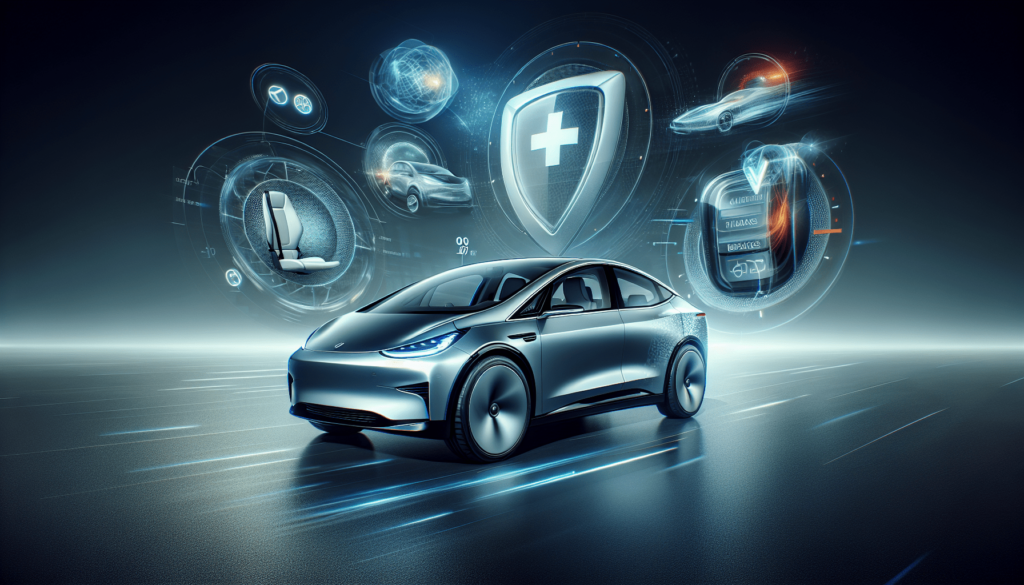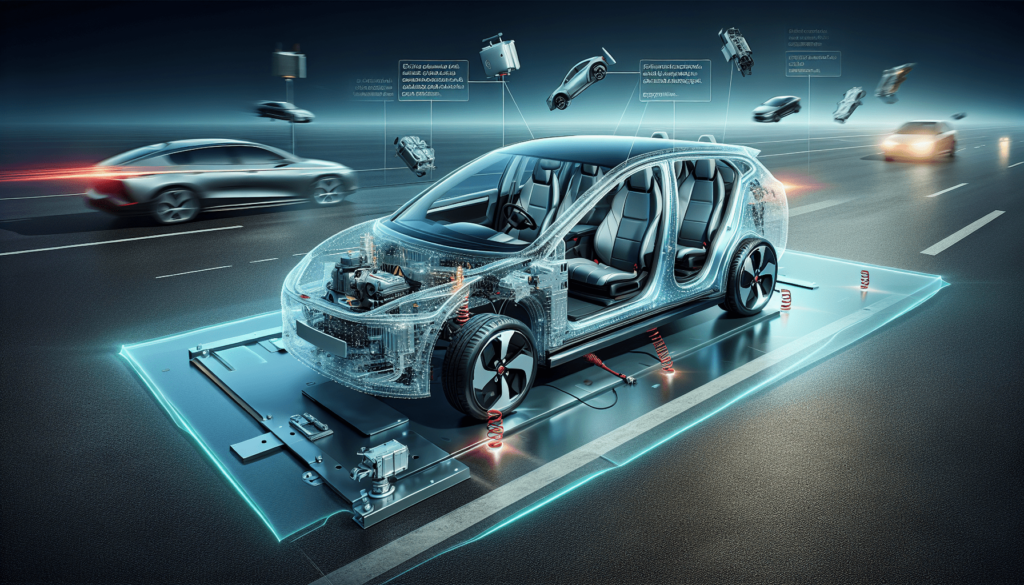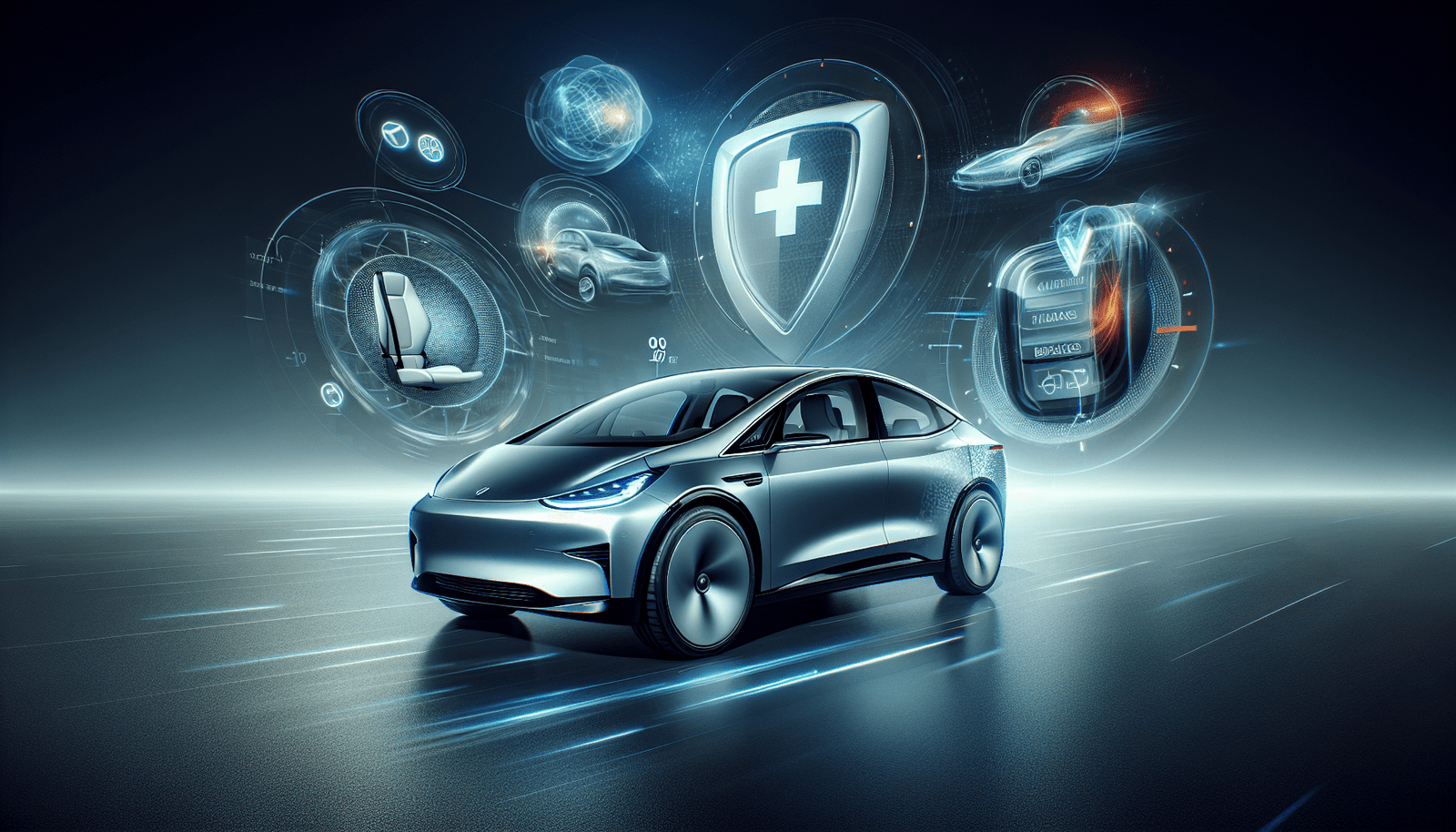Are you curious about the latest advancements in electric vehicle safety features? Look no further! In this article, we will explore the key advancements that have been made to ensure the safety of both drivers and passengers. From intelligent crash avoidance systems to enhanced battery protection, electric vehicles are leading the way in revolutionizing road safety. So, let’s buckle up and discover how these advancements are shaping the future of transportation. Electric vehicles (EVs) have seen significant advancements in safety features in recent years, making them a viable and safe option for consumers. From crash prevention systems to battery safety and cybersecurity measures, EV manufacturers have gone above and beyond to prioritize the safety of their vehicles and the people who drive them. In this comprehensive article, we will explore the various safety features and advancements in electric vehicles, ensuring that you have a clear understanding of the measures taken to keep you and your loved ones safe on the road.
Crash Prevention Features
Automatic Emergency Braking
One of the most crucial advancements in EV safety is the automatic emergency braking system, which uses sensors to detect the presence of obstacles or potential collisions. This feature provides an added layer of protection by applying the brakes automatically if it senses an imminent collision. By significantly reducing the risk of rear-end collisions, automatic emergency braking enhances overall road safety and gives you peace of mind when driving your electric vehicle.
Forward Collision Warning
Working in tandem with automatic emergency braking, forward collision warning systems monitor the distance between your EV and the vehicle ahead. Utilizing advanced sensors, these systems can detect if you are approaching another vehicle too quickly, thus providing warnings to alert you of a potential collision. This feature allows you to react promptly and take evasive action, minimizing the risk of accidents caused by inattentiveness or misjudgment.
Lane Departure Warning
Lane departure warning systems use cameras or sensors to monitor the position of your EV within its designated lane. If your vehicle drifts out of its lane unintentionally, a visual or audible alert will notify you, prompting you to correct your course. By preventing unintentional lane departures, this feature reduces the likelihood of dangerous side-swipe collisions, especially on highways and busy roads.
Adaptive Cruise Control
Adaptive cruise control (ACC) takes traditional cruise control to a new level by incorporating radar or laser sensors to maintain a safe distance from the vehicle ahead. ACC automatically adjusts your EV’s speed to match the flow of traffic, ensuring a consistent, safe following distance. By mitigating the risk of rear-end collisions and allowing for smoother, stress-free highway driving, adaptive cruise control enhances the overall driving experience while prioritizing safety.
Active Safety Systems
Anti-lock Braking System (ABS)
The anti-lock braking system is a standard safety feature found in most vehicles, including electric ones. ABS prevents wheel lock-up during hard braking, allowing you to maintain steering control and avoid skidding. By pulsating the brakes rapidly, ABS helps ensure that your EV comes to a controlled stop, even in hazardous road conditions. This technology significantly enhances braking performance, making your electric vehicle safer and more reliable.
Electronic Stability Control (ESC)
Electronic stability control systems are designed to prevent loss of control and skidding during sudden maneuvers or slippery road conditions. By monitoring your EV’s trajectory, ESC can selectively apply individual brakes and adjust engine power to maintain stability and prevent rollovers. This active safety system contributes to improved handling, especially in emergency situations, helping you maintain control and stay safe on the road.
Traction Control System (TCS)
Traction control systems work in conjunction with ABS and ESC to maximize tire grip and prevent wheel spin. By selectively applying the brakes and reducing engine power when accelerating, TCS ensures optimal traction on slippery surfaces. This feature enhances both acceleration and cornering performance, allowing for safer driving in challenging weather conditions.
Tire Pressure Monitoring System (TPMS)
Maintaining proper tire pressure is vital for safe driving, and TPMS helps you stay on top of this important task. Tire pressure monitoring systems constantly monitor the air pressure in each tire and alert you if the pressure falls below the recommended level. By keeping your tires properly inflated, TPMS not only optimizes fuel efficiency but also enhances handling and reduces the risk of tire blowouts, ensuring a safer driving experience.

Passive Safety Features
Structure and Materials
Electric vehicles are built using advanced materials, such as high-strength steel and aluminum, which provide enhanced structural rigidity and crash protection. These materials are strategically placed to absorb and disperse energy during a collision, reducing the impact on the vehicle occupants. EV manufacturers also utilize innovative design techniques that incorporate crumple zones and reinforced frames to maximize safety in the event of a crash.
Airbags
Airbags have long been an integral part of vehicle safety, and EVs are no exception. These inflatable cushions deploy in a fraction of a second during a crash to provide a buffer between the occupants and hard surfaces, such as the steering wheel, dashboard, or side panels. Modern electric vehicles are equipped with a plethora of airbags, including front, side, curtain, and knee airbags, ensuring comprehensive protection for all occupants.
Seat Belts
Seat belts are the primary safety feature in any vehicle, and EVs are equipped with advanced seat belt systems to enhance occupant safety. These systems include pre-tensioners, which retract the belt rapidly during a collision, and force limiters, which mitigate the risk of chest and abdominal injuries. In addition, electric vehicles may also feature seat belt reminders, ensuring that all occupants are properly buckled up before setting off.
Child Safety Restraints
Child safety restraints play a crucial role in protecting the youngest passengers in an EV. Electric vehicles typically come with dedicated anchor points, known as LATCH (Lower Anchors and Tethers for Children), to secure child safety seats with ease. Additionally, EV manufacturers often provide child safety locks to prevent unintentional opening of rear doors or windows, ensuring the safety and well-being of young passengers.
Battery Safety
Battery Management System
The battery management system (BMS) is a critical component in electric vehicles that monitors the health, temperature, and overall performance of the battery pack. By continuously monitoring the state of charge and regulating battery temperature, the BMS ensures the optimal operation of the battery system. In the event of a malfunction or abnormality, the BMS will take appropriate actions, such as shutting down or isolating the affected modules, to prevent further issues and maintain battery safety.
Thermal Management
Proper thermal management is essential for the safety and longevity of electric vehicle batteries. EV manufacturers employ sophisticated cooling systems that regulate the temperature of the battery pack, optimizing its performance and preventing overheating. These systems use liquid or air cooling methods to maintain the battery within a safe operating temperature range, ensuring optimal charging and discharging efficiency while reducing the risk of thermal runaway.
Crash Protection
Electric vehicle manufacturers have taken extensive measures to protect the battery pack in the event of a crash. These measures include the use of dedicated crash structures and reinforcement, ensuring that the battery remains intact and isolated from the rest of the vehicle. EVs are designed with the specific aim of preventing direct impact to the battery, reducing the risk of thermal events and potential hazards for both occupants and emergency responders.
Emergency Disconnect Systems
In the event of a crash or other emergency situations, electric vehicles are equipped with emergency disconnect systems. These systems provide a simple and reliable way to disable the high-voltage power supply, mitigating potential risks for first responders and minimizing the chance of electric shock. By allowing for quick and safe disconnection, emergency personnel can safely extricate occupants and provide the necessary assistance without the risk of further electrical hazards.

Fire Prevention and Suppression Systems
Li-ion Battery Containment
To prevent and mitigate the risk of fires, electric vehicles are designed with a robust battery containment system. In the event of a thermal event or extreme conditions, the battery pack is enclosed in a protective casing made of fire-resistant materials, often including ceramic or flame-retardant barriers. This containment system ensures that any potential fire is confined to the battery pack, reducing the risk of spreading and minimizing damage to the rest of the vehicle.
Fire Detection Systems
Electric vehicles employ advanced fire detection systems to provide early warning signs of potential fires. These systems use both thermal sensors and smoke detectors strategically placed throughout the vehicle, continuously monitoring for any abnormal heat or smoke generation. If a fire is detected, audible and visual alarms will alert the occupants, giving them ample time to safely exit the vehicle and contact emergency services.
Fire Suppression Systems
In the unlikely event of a fire, electric vehicles are equipped with fire suppression systems designed to extinguish or contain fires until help arrives. These systems typically utilize either water mist or chemical-based suppressants to smother and suppress the flames, preventing them from spreading. By providing an additional layer of protection, fire suppression systems contribute to the overall safety of electric vehicles and the surrounding environment.
Pedestrian Safety
Pedestrian Warning Speakers
Pedestrian warning speakers are an essential feature in electric vehicles, especially at low speeds. These speakers emit a distinct sound to alert pedestrians of the vehicle’s presence, as electric vehicles tend to be quieter than their internal combustion counterparts. By providing an audible warning, these speakers help ensure the safety of pedestrians, particularly those with visual impairments.
Automatic Braking for Pedestrians
To enhance pedestrian safety, electric vehicles may be equipped with automatic emergency braking systems specifically designed to detect and mitigate collisions with pedestrians. Utilizing advanced sensors and algorithms, these systems can identify pedestrians in the vehicle’s path and apply the brakes autonomously if a potential collision is imminent. By providing an additional layer of safety, automatic braking for pedestrians helps protect both the occupants of the vehicle and those outside.
External Airbags
An innovative advancement in pedestrian safety is the introduction of external airbags. These airbags deploy from the vehicle’s exterior to cushion the impact in the event of a collision with a pedestrian. By reducing the severity of injuries, external airbags offer enhanced protection to pedestrians and contribute to the overall safety reputation of electric vehicles.
Driver Assistance Features
Blind Spot Monitoring
Blind spot monitoring systems utilize sensors or cameras to detect vehicles in adjacent lanes that may not be visible through the side mirrors. When a vehicle enters your blind spot, a visual or audible alert is activated, cautioning against changing lanes. By providing an extra set of “eyes,” blind spot monitoring minimizes the risk of side-swipe collisions and helps drivers stay aware of surrounding traffic.
Parking Sensors
Parking sensors are a helpful driver assistance feature that aids in maneuvering and parking your electric vehicle with ease. Utilizing ultrasonic sensors, these systems detect obstacles or objects around your vehicle and provide audio or visual feedback to indicate their proximity. Parking sensors help prevent scrapes, dents, or collisions while maneuvering in tight spaces, allowing for stress-free parking experiences.
Rearview Cameras
Rearview cameras provide an enhanced view of the area behind your electric vehicle when reversing. By displaying the live video feed on a screen inside the vehicle, rearview cameras eliminate blind spots and offer increased visibility, helping you navigate parking lots, reverse safely, and detect potential hazards. This feature aids in avoiding collisions with objects, pedestrians, or other vehicles, ensuring a comprehensive view of your surroundings.
Surround-View Cameras
Surround-view or 360-degree cameras take the rearview camera concept to the next level by providing a complete, bird’s-eye view of your electric vehicle’s surroundings. Multiple cameras positioned strategically around the vehicle offer a composite image, allowing you to see all sides and angles simultaneously. This feature is particularly useful for maneuvering in tight spaces, improving overall situational awareness, and contributing to safer driving.
Cybersecurity Measures
Secure Communication Protocols
As vehicles become more connected and reliant on electronic systems, cybersecurity is of paramount importance. Electric vehicles employ secure communication protocols and encryption algorithms to ensure the integrity and confidentiality of data transmitted between various components, such as the battery management system, infotainment system, and external connectivity platforms. By safeguarding against unauthorized access and malicious attacks, these measures protect your privacy and maintain the overall security of the vehicle.
Tamper-Resistant Components
Electric vehicle manufacturers take measures to prevent tampering or unauthorized modifications to critical components. Tamper-resistant hardware and software systems are implemented to ensure the authenticity and integrity of key elements, such as the battery management system, firmware, and electronic control units. These measures make it significantly more challenging for potential attackers to compromise the vehicle’s security, ensuring the reliable and safe operation of the electric vehicle.
Intrusion Detection Systems
To detect and counter potential cyber threats, electric vehicles utilize intrusion detection systems that monitor and analyze network traffic within the vehicle’s electronic systems. These systems can identify and respond to any suspicious or abnormal behavior, triggering alerts and activating countermeasures. By proactively defending against cyber threats, intrusion detection systems play a crucial role in maintaining the cybersecurity of electric vehicles and protecting against potential risks.
Crash Testing and Safety Ratings
National Highway Traffic Safety Administration (NHTSA)
The National Highway Traffic Safety Administration is a United States governmental agency responsible for evaluating and setting safety standards for vehicles. NHTSA conducts comprehensive crash tests and evaluates the safety performance of electric vehicles and other automobiles. The agency assigns safety ratings to vehicles based on factors such as crashworthiness, collision avoidance, and overall safety features. By reviewing NHTSA safety ratings, consumers can make informed decisions when purchasing electric vehicles, ensuring they choose a model that meets their safety requirements.
Insurance Institute for Highway Safety (IIHS)
The Insurance Institute for Highway Safety is an independent, nonprofit organization dedicated to reducing the number of motor vehicle crashes and associated injuries and fatalities. IIHS conducts extensive research and evaluates the crashworthiness and crash avoidance capabilities of various vehicles, including electric cars. Based on their evaluations, IIHS assigns safety ratings to vehicles, with the highest rating being “Top Safety Pick+.” By considering IIHS safety ratings, consumers can gain valuable insights into the safety performance of electric vehicles, making informed choices and prioritizing safety on the road.
Regulatory Advancements
Improved Safety Standards
As electric vehicles gain popularity and become more prevalent on the roads, regulatory bodies worldwide have recognized the need to update and improve existing safety standards. Governments and organizations are constantly reassessing safety requirements to address the unique characteristics and challenges posed by electric vehicles. These advancements ensure that electric vehicles meet stringent safety standards, fostering consumer confidence and driving overall improvements in the safety of electric vehicles.
Mandated Safety Features
To enhance the safety of electric vehicles and the occupants within them, many countries and jurisdictions have implemented regulations mandating specific safety features. These mandates often include requirements for features such as automatic emergency braking, forward collision warning systems, lane departure warning systems, and blind spot monitoring. By making these safety features standard across electric vehicle models, governments aim to reduce accidents, injuries, and fatalities on the road, encouraging the adoption of safer transportation options.
In conclusion, a significant number of key advancements in electric vehicle safety features have been made to ensure the protection of occupants, pedestrians, and the overall security of EVs. From crash prevention and active safety systems to battery safety, fire prevention, and cybersecurity measures, electric vehicle manufacturers have prioritized safety in every aspect of design and functionality. By incorporating innovative technologies, adhering to stringent safety standards, and embracing continuous improvement, the electric vehicle industry is paving the way for a future of safe and sustainable transportation.

